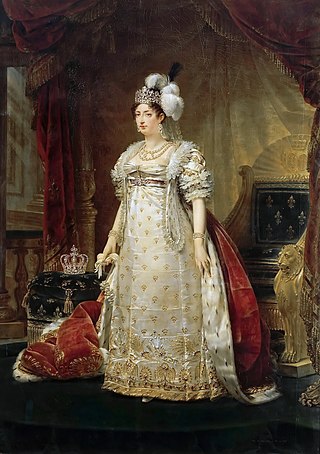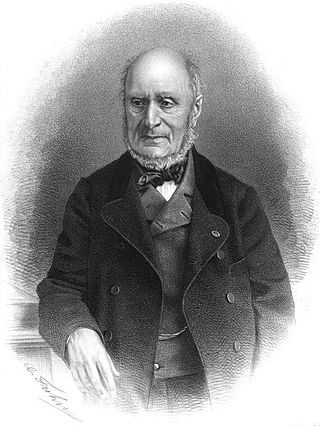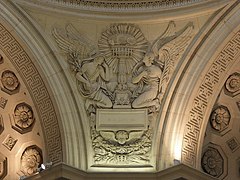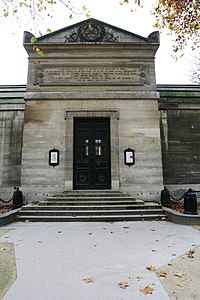
Louis XVI was the last king of France before the fall of the monarchy during the French Revolution.

Louis XVIII, known as the Desired, was King of France from 1814 to 1824, except for a brief interruption during the Hundred Days in 1815. Before his reign, he spent 23 years in exile from France beginning in 1791, during the French Revolution and the First French Empire.

The Basilica of Saint-Denis is a large former medieval abbey church and present cathedral in the commune of Saint-Denis, a northern suburb of Paris. The building is of singular importance historically and architecturally as its choir, completed in 1144, is widely considered the first structure to employ all of the elements of Gothic architecture.

The Conciergerie is a former courthouse and prison in Paris, France, located on the west of the Île de la Cité, below the Palais de Justice. It was originally part of the former royal palace, the Palais de la Cité, which also included the Sainte-Chapelle. Two large medieval halls remain from the royal palace. During the French Revolution, 2,780 prisoners, including Marie Antoinette, were imprisoned, tried and sentenced at the Conciergerie, then sent to different sites to be executed by the guillotine. It is now a national monument and museum.

The Place de la Concorde is a public square in Paris, France. Measuring 7.6 ha in area, it is the largest square in the French capital. It is located in the city's eighth arrondissement, at the eastern end of the Champs-Élysées.

The Church of Sainte-Marie-Madeleine, or less formally, La Madeleine, is a Catholic parish church on Place de la Madeleine in the 8th arrondissement of Paris. It was planned by Louis XV as the focal point of the new Rue Royal, leading to the new Place Louis XV, the present Place de la Concorde. It was dedicated in 1764 by Louis XV, but work halted due to the French Revolution. Napoleon Bonaparte had it redesigned in the Neoclassical style to become a monument to the glory of his armies. After his downfall in 1814, construction as a church resumed, but it was not completed until 1842. The building is surrounded on all four sides by Corinthian columns. The interior is noted for its frescoes on the domed ceiling, and monumental sculptures by François Rude, Carlo Marochetti and other prominent 19th-century French artists.

Île de la Cité, 22.5 hectares in size, is one of two natural islands in the Seine, in central Paris. In the 4th century, it was the site of the fortress of the area governor for the Roman Empire. In 508, Clovis I, the first King of the Franks, established his palace on the island. In the 12th century, it became an important religious center, the home of Notre-Dame cathedral, and the royal chapel of Sainte-Chapelle, as well as the city hospital, the Hôtel-Dieu. It is also the site of the city's oldest surviving bridge, the Pont Neuf.

The Château de Vincennes is a former fortress and royal residence next to the town of Vincennes, on the eastern edge of Paris, alongside the Bois de Vincennes. It was largely built between 1361 and 1369, and was a preferred residence, after the Palais de la Cité, of French kings in the 14th to 16th century. It is particularly known for its "donjon" or keep, a fortified central tower, the tallest in Europe, built in the 14th century, and for the chapel, Sainte-Chapelle de Vincennes, begun in 1379 but not completed until 1552, which is an exceptional example of Flamboyant Gothic architecture. Because of its fortifications, the château was often used as a royal sanctuary in times of trouble, and later as a prison and military headquarters. The chapel was listed as an historic monument in 1853, and the keep was listed in 1913. Most of the building is now open to the public.

Louis Joseph de Bourbon was Prince of Condé from 1740 to his death. A member of the House of Bourbon, he held the prestigious rank of Prince du Sang.

Marie-Thérèse Charlotte was the eldest child of King Louis XVI and Queen Marie Antoinette of France, and their only child to reach adulthood. In 1799 she married her cousin Louis Antoine, Duke of Angoulême, the eldest son of Charles, Count of Artois, henceforth becoming the Duchess of Angoulême. She was briefly Queen of France in 1830.

Baron François Joseph Bosio was a Monegasque sculptor who achieved distinction in the first quarter of the nineteenth century with his work for Napoleon and for the restored French monarchy.

Pierre-François-Léonard Fontaine was a French neoclassical architect, interior decorator, designer and artist.

The grand appartement de la reine is the Queen's grand apartment of the Palace of Versailles.

The present chapel of the Palace of Versailles is the fifth in the history of the palace. These chapels evolved with the expansion of the château and formed the focal point of the daily life of the court during the Ancien Régime.

Louis-Hippolyte Lebas was a French architect working in a rational and severe Neoclassical style.

The Palais de la Cité, located on the Île de la Cité in the Seine River in the centre of Paris, is a major historic building that was the residence of the Kings of France from the sixth century until the 14th century, and has been the center of the French justice system ever since, thus often referred to as the Palais de Justice. From the 14th century until the French Revolution, it was the headquarters of the Parlement of Paris. During the Revolution it served as a courthouse and prison, where Marie Antoinette and other prisoners were held and tried by the Revolutionary Tribunal. Since the early 19th century, it has been the seat of the Tribunal de grande instance de Paris, the Court of Appeal of Paris, and the Court of Cassation. The first of these moved to another Parisian location in 2018, while the other two jurisdictions remain located in the Palais de la Cité as of 2022.

Louis XVI, former King of France since the abolition of the monarchy, was publicly executed on 21 January 1793 during the French Revolution at the Place de la Révolution in Paris. At his trial four days prior, the National Convention had convicted the former king of high treason in a near-unanimous vote; while no one voted "not guilty", several deputies abstained. Ultimately, they condemned him to death by a simple majority. The execution by guillotine was performed by Charles-Henri Sanson, then High Executioner of the French First Republic and previously royal executioner under Louis.

Errancis Cemetery or Cimetière des Errancis is a former cemetery in the 8th arrondissement of Paris and was one of the cemeteries used to dispose of the corpses of guillotine victims during the French Revolution.
Madeleine Cemetery is a former cemetery in the 8th arrondissement of Paris and was one of the four cemeteries used to dispose of the corpses of guillotine victims during the French Revolution. The cemetery was named after Mary Magdalene, known in French as Sainte-Madeleine.
The French Restoration style was predominantly Neoclassicism, though it also showed the beginnings of Romanticism in music and literature. The term describes the arts, architecture, and decorative arts of the Bourbon Restoration period (1814–1830), during the reign of Louis XVIII and Charles X from the fall of Napoleon to the July Revolution of 1830 and the beginning of the reign of Louis-Philippe.

![]()
![]() .
.































